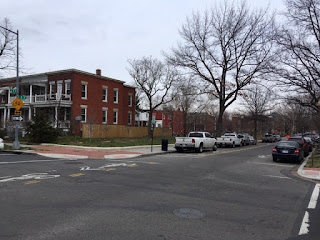 |
| WABA traning session is convened by Tamara Evans |
Maryland Avenue NE is one of the picturesque diagonal thoroughfares designed in the 1790s by Charles L'Enfant. Running four lanes NE/SW between Stanton Park and H Street, it features speeding cars and difficult sight lines that pose hazards to cyclists and pedestrians. WABA member Todd Hettenbach described the conversations between neighborhood residents, their 6th ward representative on the City Council and transportation officials that led to a redesign plan including bike lanes, a center turning lane, and bumpouts at key intersections:
Once agreement on the plan was reached, it took several years to get District Department of Transportation (DDOT) commitment to carrying it out. Hettenbach reported supporters were persistent and omnipresent at Council and DDOT meetings as well as holding meeting of their own, telling their stories to media--one mother reported her children didn't like crossing that street on their way to school because she held their hands so tightly it hurt--and using e-mail groups to stay connected. In 2016, when DDOT began to move on the project, new neighbors who hadn't been involved in the earlier discussions raised often-vociferous objection. Advocates were able to reach out at least to some of them and address their concerns (like parking, traffic jams, whether you could still turn left--familiar themes everywhere, I'm sure). At last the project seems good to go, although the federal budget situation continues to be a wild card.
H Street NE is a four-lane east-west thoroughfare in a core neighborhood that suffered greatly in the riots of the 1960s and is only recently being redeveloped. One of the features of that redevelopment is a streetcar that began runs in early 2016 from near Union Station to near RFK Stadium. The streetcar runs on tracks in the right lanes each way, which understandably complicates bicycling. Group member Joe McCann cited the owner of the Daily Rider bike shop who reported getting one bicycle a week damaged from encounters with the tracks--not to mention the damage to the rider.
McCann's group arranged for a walk-through with 6th ward Advisory Neighborhood Commission members and DDOT officials on an evening which clarified the problem for them. Since the tracks weren't going anywhere, the discussion hit on guiding people to parallel streets a block over. G and I lacked the creative potential of Maryland Avenue, being narrow one-way streets with residential parking. (Very few residents in this neighborhood have garages or driveways, so on-street parking is essential.) The solution turned out to be "contra-flow lanes," one-way bike lanes going opposite to auto traffic.
At 0.75 miles each they are claimed to be the longest contra-flow lanes in the country. Here's the one on G Street:
And I Street:
The well-attended meeting produced an impressive list of ideas about where bike lanes should go, as well as safety training for bikers--there are the usual horror stories here about rogue cyclists--and bike elevators for steep hills. Some of the infrastructure is already in the Move DC Plan, adopted in 2014. One street near me that got a lot of attention is K Street NE, which serves J.O. Wilson Elementary School...
...and connects the neighborhood to downtown Washington, but has no bike infrastructure as well as problematic interfaces with 8th Street/West Virginia Avenue...
...and 12th Street/Florida Avenue (Hennigan 2017). Here is WABA's preferred alternative, which adds bike lanes at the cost of parking on the south side of the street:

WABA activists commended working through local government, particularly the Advisory Neighborhood Commissions (ANCs) which serve as legislative committees in each ward, and who can be game-changers in advocating for projects once they're won over. Beyond that Hettenbach advised (1) engaging with neighbors, (2) staying positive and (3) looking to "whoever you can" as an ally to help build your coalition. McCann added the importance of having "a better story than your opponent," usually involved safety improvements. In a city where many people walk and bike to school or work, safety might be an easier case to make than in a city like Cedar Rapids where advocates struggle against systemic habits of car-dependency. Even so, scuttlebutt has considerable opposition among the neighbors to the parking-for-bike-lanes trade.
 |
| Rider negotiating the intersection of K Street and 4th Street |
Strong Towns has also advocated for streets designed for pedestrians and bicycles as part of their Slow the Cars campaign: "We know that pedestrian-friendly neighborhoods are more economically productive, healthier and safer." Their new e-book, Slow the Cars: Why We Must Create Safer Streets and How to Get It Done, collects a number of essays on the subject including advice for advocates, like (1) assess the accessibility of your streets, (2) tactical urbanism, (3) encourage participation, (4) engage with public officials and (5) spread the word (Wilson 2018). Streets in the oldest part of Washington aren't full-blown stroads, but they carry a lot of auto traffic, and managing that flow in a way that is also makes biking (and walking) "fun and safe" (from WABA's mission statement) will be good for everyone.












No comments:
Post a Comment